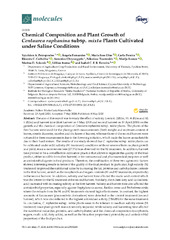Приказ основних података о документу
Chemical Composition and Plant Growth of Centaurea raphanina subsp. mixta Plants Cultivated under Saline Conditions
| dc.creator | Petropoulos, Spyridon A. | |
| dc.creator | Fernandes, Ângela | |
| dc.creator | Dias, Maria Ines | |
| dc.creator | Pereira, Carla | |
| dc.creator | Calhelha, Ricardo C. | |
| dc.creator | Chrysargyris, Antonios | |
| dc.creator | Tzortzakis, Nikolaos | |
| dc.creator | Ivanov, Marija | |
| dc.creator | Soković, Marina | |
| dc.creator | Barros, Lillian | |
| dc.creator | Ferreira, Isabel C. F. R. | |
| dc.date.accessioned | 2020-05-21T07:09:38Z | |
| dc.date.available | 2020-05-21T07:09:38Z | |
| dc.date.issued | 2020 | |
| dc.identifier.issn | 1420-3049 | |
| dc.identifier.uri | https://www.mdpi.com/1420-3049/25/9/2204 | |
| dc.identifier.uri | https://radar.ibiss.bg.ac.rs/handle/123456789/3675 | |
| dc.description.abstract | The aim of this report was to study the effect of salinity (control: 2dS/m, S1: 4 dS/m and S2: 6 dS/m) and harvest time (first harvest on 9 May 2018 and second harvest on 19 April 2018) on the growth and the chemical composition of Centaurea raphanina subsp. mixta plants. The plants of the first harvest were used for the plant growth measurements (fresh weight and moisture content of leaves, rosette diameter, number and thickness of leaves), whereas those of the second harvest were not used for these measurements due to the flowering initiation, which made the leaves unmarketable due to their hard texture. The results of our study showed that C. raphanina subsp. mixta plants can be cultivated under mild salinity (S1 treatment) conditions without severe effects on plant growth and yield, since a more severe loss (27.5%) was observed for the S2 treatment. In addition, harvest time proved to be a cost-effective cultivation practice that allows to regulate the quality of the final product, either in edible form (first harvest) or for nutraceutical and pharmaceutical purposes as well as antimicrobial agents in food products. Therefore, the combination of these two agronomic factors showed interesting results in terms of the quality of the final product. In particular, high salinity (S2 treatment) improved the nutritional value by increasing the fat, proteins and carbohydrates contents in the first harvest, as well as the tocopherols and sugars contents (S1 and S2 treatments, respectively) in the second harvest. In addition, salinity and harvest time affected the oxalic acid content which was the lowest for the S2 treatment at the second harvest. Similarly, the richest fatty acid (α-linolenic acid) increased with increasing salinity at the first harvest. Salinity and harvest time also affected the antimicrobial properties, especially against Staphylococcus aureus, Bacillus cereus and Trichoderma viride, where the extracts from the S1 and S2 treatments showed high effectiveness. In contrast, the highest amounts of flavanones (pinocembrin derivatives) were detected in the control treatment (second harvest), which was also reflected to the highest antioxidant activity (TBARS) for the same treatment. In conclusion, C. raphanina subsp. mixta plants seem to be tolerant to medium salinity stress (S1 treatment) since plant growth was not severely impaired, while salinity and harvesting time affected the nutritional value (fat, proteins, and carbohydrates) and the chemical composition (tocopherols, sugars, oxalic acid, fatty acids), as well as the bioactive properties (cytotoxicity and antimicrobial properties) of the final product. | en |
| dc.publisher | MDPI AG | |
| dc.relation | info:eu-repo/grantAgreement/MESTD/inst-2020/200007/RS// | |
| dc.relation | Foundation for Science and Technology | |
| dc.relation | 0377_Iberphenol_6_E | |
| dc.rights | openAccess | |
| dc.rights.uri | https://creativecommons.org/licenses/by/4.0/ | |
| dc.source | Molecules | |
| dc.subject | Abiotic stress | |
| dc.subject | Antimicrobial properties | |
| dc.subject | Antioxidants | |
| dc.subject | Cytotoxicity | |
| dc.subject | Flavanones | |
| dc.subject | Oxalic acid | |
| dc.subject | Pinocembrin | |
| dc.subject | Polyphenols | |
| dc.subject | Saline conditions | |
| dc.title | Chemical Composition and Plant Growth of Centaurea raphanina subsp. mixta Plants Cultivated under Saline Conditions | en |
| dc.type | article | en |
| dc.rights.license | BY | |
| dcterms.abstract | Соковић, Марина; Петропоулос, Спyридон A.; Иванов, Марија; Фернандес, Âнгела; Диас, Мариа Инес; Переира, Царла; Цхрyсаргyрис, Aнтониос; Тзортзакис, Николаос; Баррос, Лиллиан; Ферреира, Исабел Ц. Ф. Р.; Цалхелха, Рицардо Ц.; | |
| dc.rights.holder | © 2020 by the authors. Licensee MDPI, Basel, Switzerland. | |
| dc.citation.issue | 9 | |
| dc.citation.volume | 25 | |
| dc.identifier.doi | 10.3390/molecules25092204 | |
| dc.identifier.pmid | 32397258 | |
| dc.identifier.scopus | 2-s2.0-85084468698 | |
| dc.identifier.wos | 000535695900200 | |
| dc.citation.apa | Petropoulos, S. A., Fernandes, Â., Dias, M. I., Pereira, C., Calhelha, R. C., Chrysargyris, A., et al. (2020). Chemical Composition and Plant Growth of Centaurea raphanina subsp. mixta Plants Cultivated under Saline Conditions. Molecules, 25(9), 2204. | |
| dc.citation.vancouver | Petropoulos SA, Fernandes Â, Dias MI, Pereira C, Calhelha RC, Chrysargyris A, Tzortzakis N, Ivanov M, Sokovic M, Barros L, Ferreira ICFR. Chemical Composition and Plant Growth of Centaurea raphanina subsp. mixta Plants Cultivated under Saline Conditions. Molecules. 2020;25(9):2204. | |
| dc.citation.spage | 2204 | |
| dc.type.version | publishedVersion | |
| dc.identifier.fulltext | https://radar.ibiss.bg.ac.rs/bitstream/id/6193/Molecules_2020_25_9_2204.pdf | |
| dc.citation.rank | M22 |

